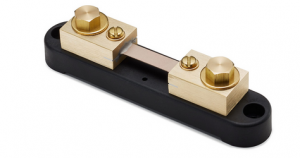Question From Client:
We have recently ordered multiple shunts from Riedon, and we are happy with the products. I have some technical questions regarding the scaling.
For instance, we have a shunt Model: MKB450/50mv .
When I look at the resistance table on your website it says 0,11 resistance. So, If I Convert it to mv it will be 450A x0,11=49.5mV
We send the shunt for calibration, and we found at 300,11A resistance value 111.96 Micro Ohm. If I Convert the mv =450Ax111.96=50.382 mV
I need your advice on scaling. Perhaps I am converting the value incorrectly. If I am correct why do we have a difference in values?
Answer:
The MKB shunts have a couple of different issues when it comes to measuring current with high accuracy.
The biggest cause of variation from expected values is the voltage sensing terminals and the position of the wire terminals.
In the following illustration, the position of the wires can make a difference of 1-2% just depending on the position.
These types of shunts don’t have the voltage sensing points directly in the current path, they are on the side.

It’s kind of like measuring the speed of a river from the shoreline, it’s better to measure from the middle of the river.
The RSN Style has voltage sensing directly between the current terminals and has much better accuracy and repeatability.

Next, the shunt TCR will cause the shunt output to change with temperature.
Running that part at 300 Amps will cause the blades to heat up and the output will change as it does.
The output will be different 1 second after applying current than after a few minutes of stabilization.
The final temperature will also be affected considerably by the size of the current-carrying conductors.
Large cables will run cooler than small cables, this could be 50C or more…
When we calibrate, it is at 20% rated current with the part at room temperature.
